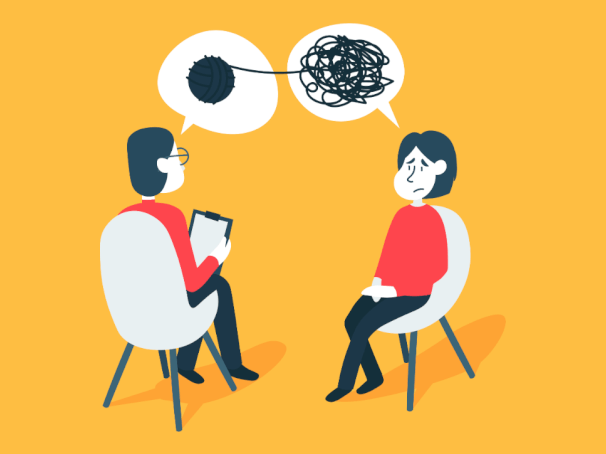
Anxiety has been around since humans were first worried about getting trampled by woolly mammoths. But historically, anxiety has by no means always been recognized as a potential mental disorder. Gaining recognition as a treatable condition took many years, and figuring out how to treat anxiety with even a modicum of success took even longer.
In this article, we'll explore how people with anxiety used to be thought of, and what they were treated with as long ago as ancient Greece.
Anxiety is the Fight or Flight System
Before getting into the history of anxiety, it's important to note that at its core level, anxiety is a part of evolution. Anxiety is the activation of the fight or flight system – the system your body uses to keep you safe from harm.
One of the key things to realize is that nervousness when confronting fear is not anxiety. Anxiety is when you get that nervousness (and all other related fight/flight symptoms) when there is no fear. Anxiety, as a disorder, is when your fight or flight system is malfunctioning. This article discusses anxiety as a disorder, but the initial history of anxiety is simply the development of the fight or flight system, which is a system that you do need in life to stay safe.
Ancient Greece: Unsettled Uteri
It was during the era of Greek rule that the term “hysteria” was coined, which would mean bad news for anxiety-prone women for centuries to come. The word “hysteria” actually has its root in the Greek cognate for the uterus, “hystera," most likely because it practitioners at the time believed it only to affect women. They believed that anxiety's “hysterical” behavior, such as panic, was in fact caused by the uterus, Which (as male philosophers hypothesized at the time) wandered around the body “blocking passages, obstructing breathing and causing disease” (Plato).
It was also suspected to be affected by the existence of “female semen,” which, when stored in the body due to a lack of sexual intercourse, would turn to poison and make the women behave in a strange, high-strung manner. Sex, naturally, was then considered to be the cure.
The Early Renaissance: Witchy Worries
During the early Renaissance, women in particular who were highly anxious and prone to “hysteria” were often accused of being witches. Premonitions about bad things happening, if they proved true, would suggest to others their witchy nature or be used against them by their enemies in a courtroom. Being vocal about your anxiety, or having physical symptoms that others could not explain any other way, caused you to be “treated” via torture (in Spain), execution (in Britain), or burning at the stake (mainly in Scotland). Ironically, being stressed out about your neighbor being a witch could set off the “hysterical” anxiety reaction that could incriminate you instead.
The Victorian Era: Bored and Batty
Similarly, during the Victorian era, women who got “hysterical” were seen as being crazy. The tension that built up from being trapped indoors without a job or anything to do led to many so-called unusual behaviors, including a popular form of crafting that involved making trinkets out of human hair. Anxiety was also one of these issues. If a woman had persistent panic attacks, her family or husband would most likely cart her off to the local insane asylum where treatments included electroshock therapy and even (in severe cases) lobotomization. Eventually, an at-home treatment for women with anxiety was invented, known in the modern day as a vibrator.
The American Civil War Era: Opium for Over Excitement
Soldiers in the American Civil War were thought to suffer from what was then called “irritable heart syndrome” when they exhibited heart palpitations and shortness of breath – something that is now known to be post-traumatic stress disorder. This was occasionally treated through the use of opium, whose addictive effects were not yet well understood. “Nerve weakness” was its name in the late 1800s when ethyl alcohol and bromide salts were added to the list of treatments.
This era actually had some benefits for the understanding of anxiety. For the first time, men were being recognized as having anxiety-related difficulties too. But on the negative side, like many of the other issues related to treating anxiety in these early periods, the treatments on offer were short-term “solutions” which ultimately made the situation worse.
Early 20th Century: Sterilizing the Psychos
The Russians seem to have been the first to catch on to the psychological nature of this condition, and began sending psychiatrists off to war along with soldiers to treat them after a battle during Russia’s war with Japan in 1904. Sedation by way of barbiturates was a popular method of medical treatment at this time. Unfortunately, for many years it was also considered appropriate to sterilize anyone suffering from a mental illness in case their condition should be transferable to children. The 1930s saw an interesting mixture of therapies for anxiety, ranging from muscle relaxation techniques to electroshock.
Late 20th Century: Modernizing Medicine
Most modern techniques for treating anxiety came into existence after the 1950s (though during this time muscle relaxation techniques are also frequently used, and even electroshock is occasionally suggested in cases of severe anxiety where patients are at risk of killing themselves). Fear exposure therapy was introduced in 1950, which called for patients to be repeatedly exposed to their fear trigger for desensitization to occur. Ten years later there was a realization that antidepressants could be effective as a treatment for anxiety as well as depression. The 1980s saw the creation of the term “anxiety disorder,” and in 1990 it was discovered that antidepressant-type drugs worked on anxiety due to depleted numbers of the neurotransmitters responsible for bringing “happy” chemicals dopamine and serotonin to the brain in anxiety patients.
Today: Looking to the Past
In the modern day, discoveries continue to be made about the potential presence of predisposal to anxiety on the genetic level. In addition to these hyper-modern ideas, therapists are also looking into the past to discover older techniques that may be able to help people without addictive side effects (such as ancient Indian practices of muscle, heart rate, and breathing control). By drawing inspiration both from the past and from modern technology, today’s scientists come ever closer to figuring out how to effectively (and harmlessly) control anxiety.









